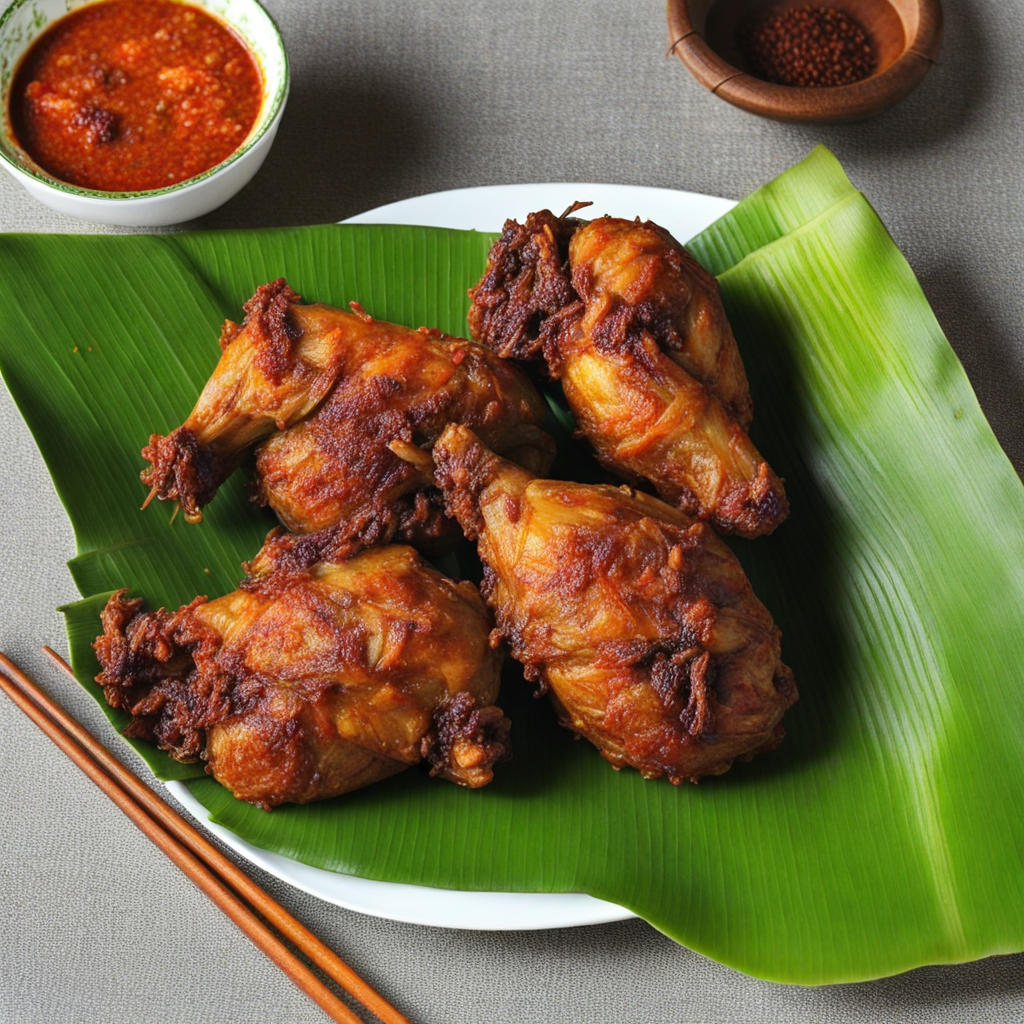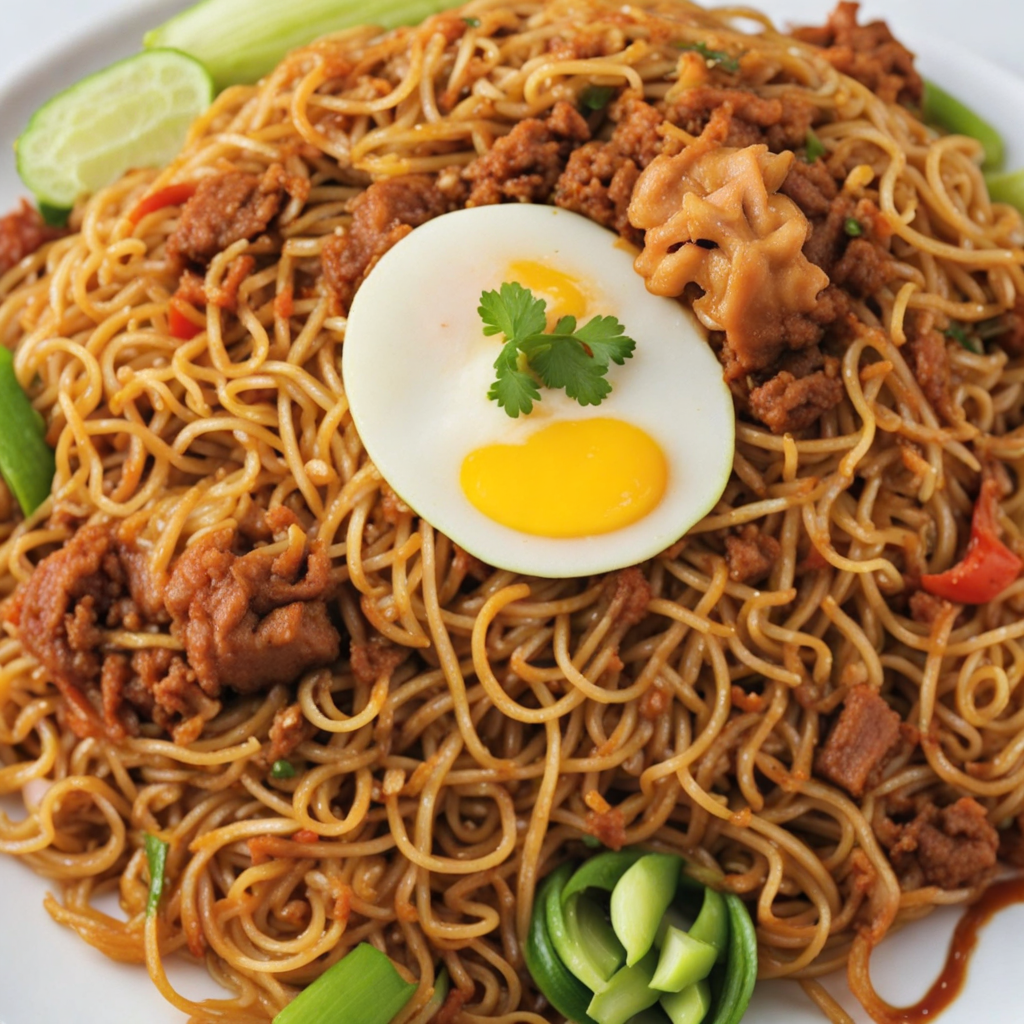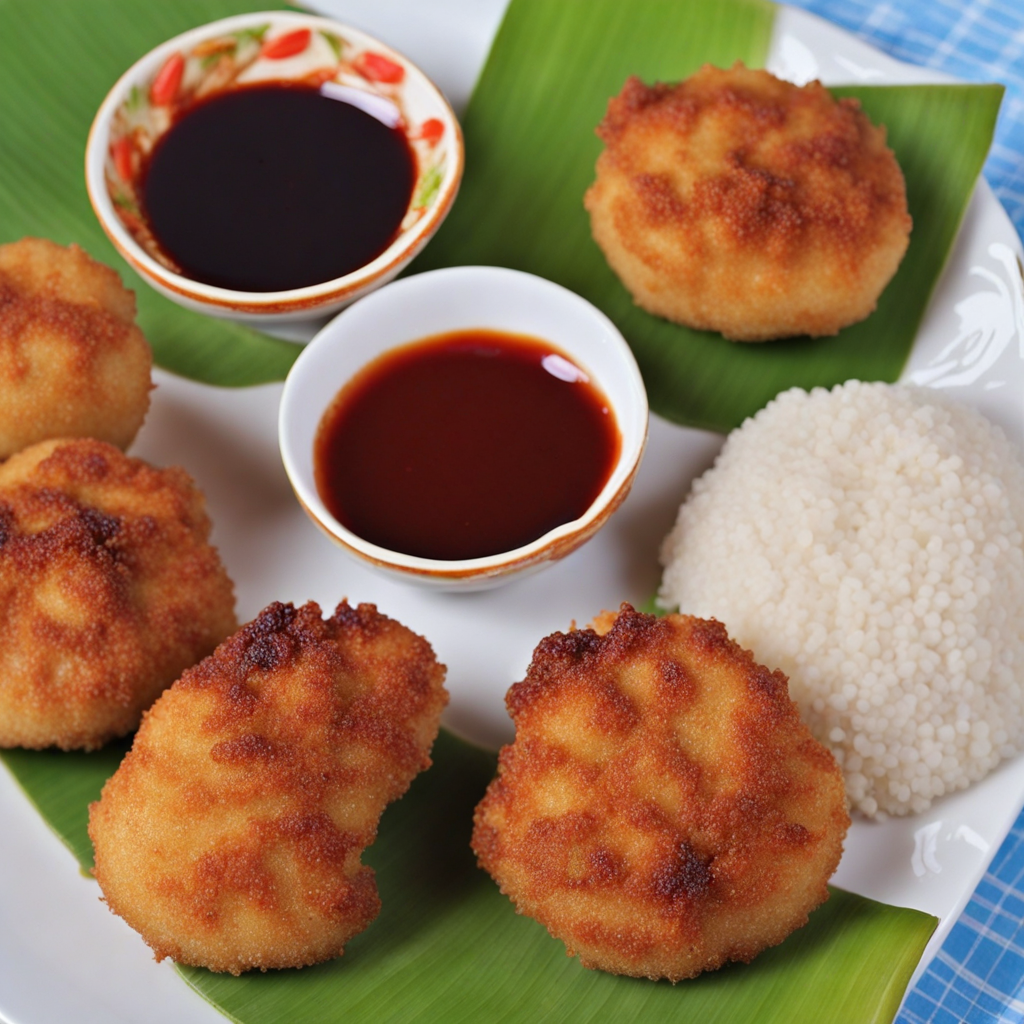Ayam Betutu
Ayam Betutu is a traditional Indonesian dish that hails from the island of Bali, renowned for its vibrant flavors and aromatic spices. This dish features a whole chicken marinated in a rich blend of spices, including turmeric, garlic, ginger, lemongrass, and chili, creating a tantalizing flavor profile that is both savory and slightly spicy. The chicken is often stuffed with a mixture of herbs and spices before being wrapped in banana leaves, ensuring that it remains moist and tender during the cooking process. The unique combination of ingredients not only infuses the chicken with bold flavors but also reflects the rich culinary heritage of Indonesia, characterized by its diverse regional influences. The preparation of Ayam Betutu is a labor of love, often requiring hours of marination to allow the spices to penetrate the meat fully. After being seasoned, the chicken is typically slow-cooked or steamed, allowing it to absorb the aromatic steam from the herbs and spices. This method results in a succulent and flavorful dish that is bursting with the essence of Bali. When served, Ayam Betutu is often accompanied by steamed rice and sambal, a spicy condiment that adds an extra kick to the meal. As you take your first bite of Ayam Betutu, you'll experience an explosion of flavors that dance on your palate. The tender meat is infused with the earthy warmth of turmeric and the refreshing zest of lemongrass, complemented by the heat of the chilies. Each mouthful transports you to the lush landscapes of Bali, where this dish is not just a meal but a celebration of culture and tradition. Whether enjoyed at a local warung or as part of a festive gathering, Ayam Betutu promises an unforgettable culinary adventure that showcases the best of Indonesian cuisine.
How It Became This Dish
Origin of Ayam Betutu Ayam Betutu is a traditional Indonesian dish that hails from the island of Bali. Its roots can be traced back to the rich culinary traditions of the Balinese people, who have always had a profound connection with their food, often intertwining it with their rituals, celebrations, and daily life. The dish consists of chicken (ayam) that is marinated in a blend of spices, wrapped in banana leaves, and then slow-cooked until tender. This method not only ensures that the chicken absorbs the complex flavors of the spices but also retains its moisture, resulting in a succulent and aromatic dish. The name "Betutu" itself is derived from the Balinese word 'betut,' which means to wrap. The practice of wrapping food in banana leaves is a common technique in many Indonesian cuisines, serving both practical and aesthetic purposes. Traditionally, Ayam Betutu was prepared for special occasions, such as religious ceremonies, weddings, and significant community events. The meticulous process of marinating and cooking the chicken was seen as an expression of love and respect, making it a dish that holds a special place in Balinese culture and cuisine. Cultural Significance In Balinese culture, food is not merely sustenance; it is a vital part of the spiritual and social fabric of the community. Ayam Betutu exemplifies this connection, as it is often associated with rituals and celebrations. The dish is commonly served during important ceremonies, such as temple festivals (odalan) and family gatherings, where food acts as an offering to the gods and a means of bringing people together. The preparation of Ayam Betutu can be seen as a form of devotion, as families gather to create this intricate dish, reinforcing bonds and sharing stories. Moreover, the spices used in Ayam Betutu are significant in Balinese cuisine. The spice blend typically includes ingredients such as garlic, ginger, turmeric, lemongrass, and chili, which not only provide flavor but also reflect the agricultural bounty of the region. This connection to local produce and traditional farming practices highlights the sustainability inherent in Balinese food culture. The use of these spices is also a testament to the historical influences on Indonesian cuisine, as trade routes and cultural exchanges have introduced various flavors and techniques over centuries. Development Over Time As the culinary landscape of Indonesia evolved, so too did Ayam Betutu. While the traditional preparation of the dish remains popular, modern interpretations have emerged. Various regions in Indonesia have developed their own versions, adapting the recipe to local tastes and available ingredients. For instance, in Lombok, a neighboring island, Ayam Betutu Lombok is characterized by a spicier and more intense flavor profile, reflecting the local palate's preference for heat. With the rise of tourism in Bali, Ayam Betutu has gained international recognition and has been integrated into the menus of many restaurants, both in Indonesia and abroad. This exposure has led to a fusion of styles, where chefs experiment with different cooking methods, such as grilling or using contemporary techniques like sous-vide, while still aiming to honor the traditional flavors and essence of the dish. This evolution has not only popularized Ayam Betutu but has also encouraged an appreciation for Balinese culinary heritage among a broader audience. Regional Variations The beauty of Ayam Betutu lies in its adaptability, which is reflected in its numerous regional variations across Indonesia. Each version carries unique flavors, influenced by local ingredients and culinary practices. For example, in some areas, duck is used instead of chicken, resulting in a richer flavor profile. The spice mix might also vary, with some regions opting for sweeter or more pungent blends, showcasing the diversity of Indonesian cuisine. In addition to regional differences, Ayam Betutu is often served with accompaniments that vary from place to place. In Bali, it is typically accompanied by steamed rice, sambal (a spicy condiment), and a side of vegetables, creating a harmonious balance of flavors and textures. This aspect of the dish highlights the importance of communal dining in Indonesian culture, where meals are often shared and enjoyed together. Ayam Betutu in Contemporary Cuisine In recent years, there has been a resurgence of interest in traditional Indonesian foods, with Ayam Betutu at the forefront. Chefs and home cooks alike are increasingly seeking to reconnect with their culinary roots, leading to a revival of traditional recipes and techniques. Culinary festivals and food events in Indonesia and beyond have celebrated Ayam Betutu, showcasing its cultural significance and inviting a new generation to appreciate this cherished dish. Moreover, the global rise in interest in authentic and diverse cuisines has brought Ayam Betutu to the attention of food enthusiasts worldwide. Cooking classes and online tutorials have made it accessible for individuals to recreate this traditional dish in their own kitchens, fostering a greater understanding of Indonesian culinary practices. As people embrace the flavors of Ayam Betutu, it serves as a cultural ambassador, sharing the richness of Balinese culture with a global audience. Conclusion Ayam Betutu is more than just a dish; it encapsulates the essence of Indonesian culinary heritage, reflecting the deep-rooted traditions, cultural significance, and regional diversity of the archipelago. From its origins in Bali, where it has been lovingly prepared for generations, to its contemporary interpretations found in restaurants worldwide, Ayam Betutu continues to evolve while remaining a symbol of community, celebration, and connection to the land. As it gains recognition on the global stage, this iconic dish serves as a reminder of the importance of preserving culinary traditions and the stories that food can tell.
You may like
Discover local flavors from Indonesia







